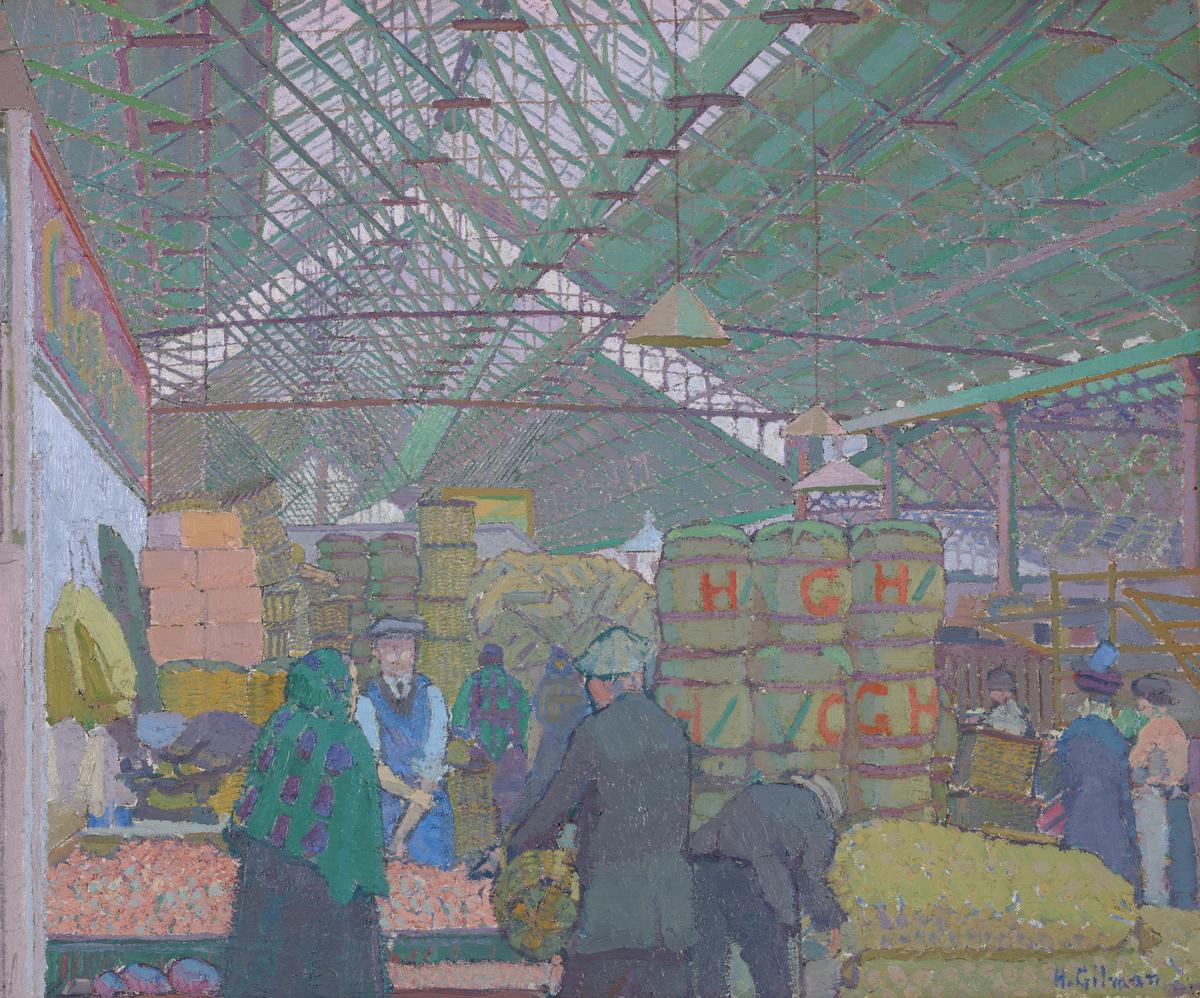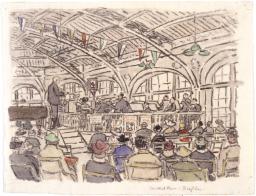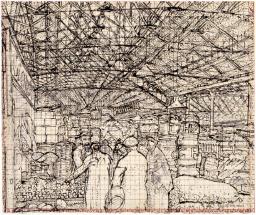Harold Gilman Leeds Market c.1913
Harold Gilman,
Leeds Market
c.1913
At the time Harold Gilman produced this painting, Leeds Market was one of the largest purpose-built markets in the country, with over half of its area enclosed by a large cast iron and glass market hall. The structure of the hall’s glass roof figures prominently, through which light filters onto the figures below. Walter Sickert described the colour of the roof as ‘artichoke green and artichoke violet’.
Harold Gilman 1876–1919
Leeds Market
c.1913
Oil paint on canvas
508 x 610 mm
Inscribed by the artist ‘H. Gilman’ bottom right
Presented by the Very Reverend E. Milner White 1927
N04273
c.1913
Oil paint on canvas
508 x 610 mm
Inscribed by the artist ‘H. Gilman’ bottom right
Presented by the Very Reverend E. Milner White 1927
N04273
Ownership history
Walter Taylor (1860–1943), probably bought at the 1915 London Group exhibition; bought for £50 at French Gallery, London, 1922 by the Very Reverend Eric Milner White (1884–1963), by whom presented to Tate Gallery 1927.
Exhibition history
1915
The Third Exhibition of Works by Members of the London Group, Goupil Gallery, London, November–December 1915 (61).
1922
Exhibition of Modern British Art, Whitechapel Art Gallery, London, March–April 1922 (84).
1922
Pictures by Modern British and Foreign Artists, French Gallery, London, November 1922 (40).
1930
The One Hundred and Fourth Exhibition of the Royal Scottish Academy of Painting, Sculpture, and Architecture, Royal Scottish Academy, Edinburgh, 1930 (279).
1934
Modern British Painting, Leeds City Art Gallery 1934 (17).
1937
Sixty Pictures of Yorkshire Scenery, Leeds City Art Gallery, June–July 1937 (14).
1939–40
Exhibition of Contemporary British Art, (British Council tour), British Pavilion, World’s Fair, New York, April–October 1939 (30), National Gallery of Canada, Ottawa, December 1939 (30), Art Gallery of Toronto, January 1940, Museum of Fine Arts, Montreal, February 1940, Museum of Fine Arts, Boston, May–September 1940 (30), Arts Club, Chicago, November 1940 (15).
1943
Exposicion de Art Britanico Contemporaneo, (British Council tour in South America), Montevideo and Rio de Janeiro, 1943 (22, as ‘Mercado de Leeds’).
1954–5
Harold Gilman 1876–1919, (Arts Council tour), Arts Council, London, January–December 1954, Manchester Art Gallery, November–December 1954, Tate Gallery, London, May–June 1955 (23).
1960
British Painting 1700–1960, (British Council tour), Pushkin Museum, Moscow, May–June 1960, Hermitage Museum, Leningrad, June–July 1960 (94).
1964
London Group 1914–64: Jubilee Exhibition, (Arts Council tour), Tate Gallery, London, July–August 1964, National Museum of Wales, Cardiff, August–September 1964, Doncaster Museum and Art Gallery, October 1964 (15, reproduced).
1960
British Painting 1700–1960, (British Council tour), Pushkin Museum, Moscow, May–June 1960, Hermitage, Leningrad, June–July 1960 (94).
1969
Harold Gilman 1876–1919: An English Post-Impressionist, The Minories, Colchester, March 1969, Ashmolean Museum, Oxford, April–May 1969, Graves Art Gallery, Sheffield, May–June 1969 (35).
1981–2
Harold Gilman 1876–1919, (Arts Council tour), City Museum and Art Gallery, Stoke-on-Trent, October–November 1981, York City Art Gallery, November 1981–January 1982, Birmingham Museum and Art Gallery, January–February 1982, Royal Academy of Arts, London, February–April 1982 (61, reproduced).
1998–9
Lucien Pissarro et le post-impressionisme anglais, Musée de Pontoise, November 1998–March 1999, Chateau-Musée, Dieppe, March–June 1999 (69, reproduced).
2002
Harold Gilman and William Ratcliffe, Southampton City Art Gallery, April–July 2002 (no number).
2008
Modern Painters: The Camden Town Group, Tate Britain, London, February–May 2008 (76, reproduced).
References
1915
Frank Rutter, Sunday Times, 28 November 1915.
1915
P.G. Konody, Observer, 28 November 1915.
1915
O.R. Drey, Westminster Gazette, 1 December 1915.
1915
Athenæum, 4 December 1915, p.424.
1916
Walter Sickert, ‘A Monthly Chronicle: The London Group’, Burlington Magazine, vol. 28, no.154, January 1916, p.164.
1919
Wyndham Lewis and Louis F. Fergusson, Harold Gilman: An Appreciation, London 1919, pp.27, 29, reproduced p.71.
1922
Frank Rutter, Some Contemporary Artists, London 1922, p.134.
1937
Mary Chamot, Modern Painting in England, London 1937, p.46.
c.1938
Frank Rutter, Modern Masterpieces: An Outline of Modern Art, London c.1938, p.202.
1950
Maurice de Sausmarez, ‘Camden Town Group Pictures in the Leeds Collection’, Leeds Art Calendar, Spring 1950, p.18.
1951
Hesketh Hubbard, A Hundred Years of British Painting 1851–1951, London 1951, reproduced pl.82.
1955
Dennis Farr, ‘Harold Gilman 1876–1919’, Burlington Magazine, vol.97, no.627, June 1955, p.184, reproduced p.189.
1964
Mary Chamot, Dennis Farr and Martin Butlin, Tate Gallery Catalogues: The Modern British Paintings, Drawings and Sculpture, vol.1, London 1964, p.235.
1978
Dennis Farr, English Art 1870–1940, Oxford 1978, pp.206–7, reproduced pl.75a.
1979
Wendy Baron, The Camden Town Group, London 1979, pp.221, 368.
1980
Simon Watney, English Post-Impressionism, London 1980, pp.66, 112, 118, reproduced pl.22.
1981
Charles Harrison, English Art and Modernism 1900–1939, New Haven and London 1981, reproduced fig.19.
1982
Roy A. Perry, ‘Harold Gilman: Canal Bridge, Flekkefjord’, in Stephen Hackney (ed.), Completing the Picture: The Materials and Techniques of Twenty-Six Paintings in the Tate Gallery, London 1982, pp.77–81, reproduced p.78.
1987
British Modernist Art 1905–1930, exhibition catalogue, Hirschl and Adler Galleries, New York 1987, p.20.
1992
Maureen Connett, Walter Sickert and the Camden Town Group, Newton Abbott 1992, p.49, reproduced p.46.
2000
Wendy Baron, Perfect Moderns: A History of the Camden Town Group, Aldershot and Vermont 2000, p.169.
2000
Anna Gruetzner Robins (ed.), Walter Sickert: The Complete Writings on Art, Oxford and New York 2000, p.401, reproduced fig.28.
2001
David Peters Corbett, Walter Sickert, London 2001, p.44, reproduced p.43.
Technique and condition
Leeds Market is painted on fine plain-weave linen that appears to have been prepared in the same way as Gilman’s other works in the Tate collection (see also Tate T00096). All four edges are marked with lines evenly spaced at half-inch intervals in a fluid red medium. This relates directly to the numbered red ink grid on Gilman’s pen and ink preparatory drawing (Tate T00143). Microscopic traces of red ink are detectable in the interstices formed by high impasto, confirming that Gilman applied a continuous red ink grid to transfer the drawing onto the primed canvas. Initial drawing was probably in the dry black graphic medium, which is visible at the unpainted edges of the forms. The composition of the painting follows the drawing closely, with few changes. There is no evidence of reworking.
The paint film is composed of opaque blocks of colour applied within the outlines of the drawing, leaving white primer exposed at the edges of the shapes. Colour is overlaid with colour from a loaded brush with minimum intermixing. The graphite annotations on the study (Tate T00143) recording colour values appear to have been adhered to, and modulation of hue and tone within the blocks of colour is limited. The consistency of the paint was a critical part of the application. Through varying the medium content, Gilman could control flow and work within the boundaries of the drawn shapes. Marked variations in surface gloss (the painting is unvarnished), suggest that Gilman was still experimenting with his paint. In some areas, the colour has ‘sunk’, where fresh paint has been applied onto touch-dry paint and medium from the layer above has been absorbed into the layer beneath. Gilman described the careful consideration that he gave to the properties of his paint in response to Walter Sickert’s infamous criticism of his own and Ginner’s use of ‘thick paint’: ‘I am not acquainted with any man who thinks there is any merit in thick paint for the sake of thick paint ... It is, in any case, a technical detail, and depends on the questions of brilliance, permanence, covering power, deliberateness of workmanship, etc.’1
Sarah Morgan and Roy Perry
June 2005
Notes
How to cite
Sarah Morgan and Roy Perry, 'Technique and Condition', June 2005, in Robert Upstone, ‘Leeds Market c.1913 by Harold Gilman’, catalogue entry, May 2009, in Helena Bonett, Ysanne Holt, Jennifer Mundy (eds.), The Camden Town Group in Context, Tate Research Publication, May 2012, https://wwwEntry
The inspiration for this work may have come from a visit Harold Gilman made to the art critic and writer Frank Rutter, who became Director of Leeds City Art Gallery in 1912. Rutter was an enthusiastic admirer and reviewer of Gilman’s work, and the two became friends. Gilman shows the eastern extension of the City Market at Leeds, a section that was erected between 1897 and 1901. His viewpoint looks east towards the windows and gable.
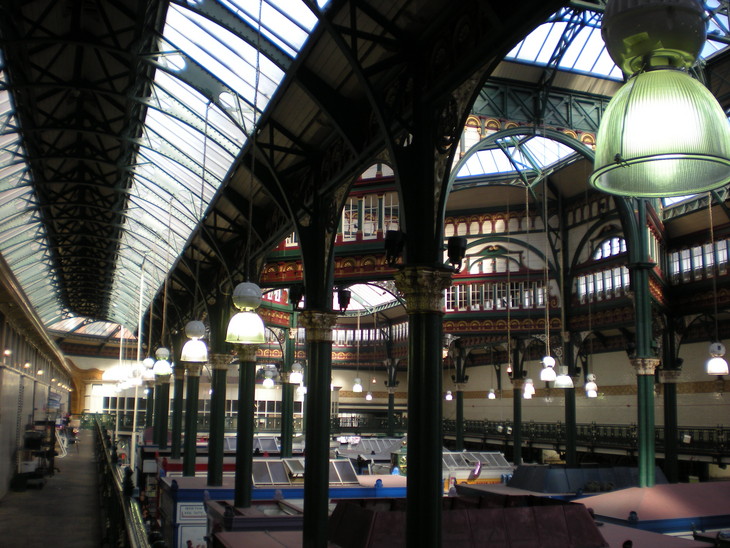
The roof of Leeds Market in the adjoining hall to where Gilman's painting was made
Photo © Tate
Fig.1
The roof of Leeds Market in the adjoining hall to where Gilman's painting was made
Photo © Tate
In an unsigned review of the 1915 London Group exhibition in the Burlington Magazine, Walter Sickert, by this time mostly out of sympathy with Gilman’s work, wrote perhaps somewhat sardonically:
Gilman touches a high level in his ‘Leeds Market’. The intricate drawing of the roof in tones of artichoke green and artichoke violet is an expression of something only found by a born painter intensely interested in his subject.2
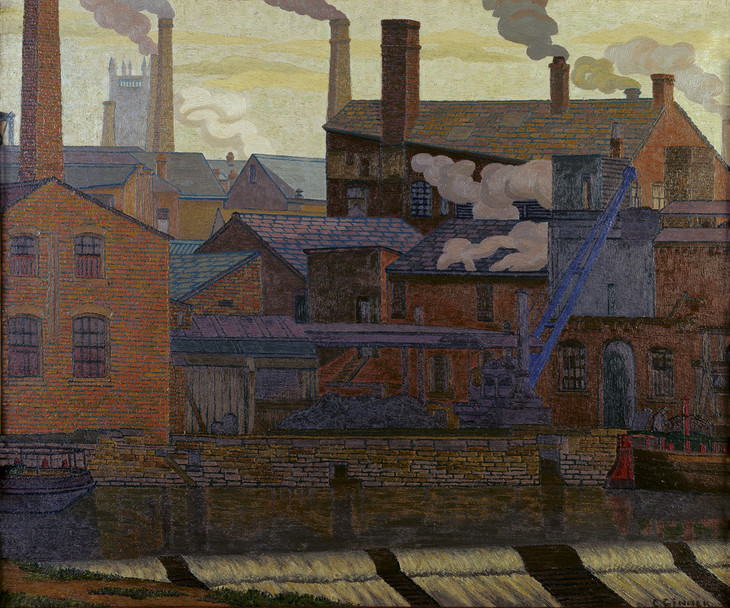
Charles Ginner 1878–1952
Leeds Canal 1914
Oil paint on canvas
736 x 584 mm
Leeds Museums and Galleries (City Art Gallery)
© Estate of Charles Ginner
Photo © Leeds Museums and Galleries (City Art Gallery) UK / The Bridgeman Art Library
Fig.2
Charles Ginner
Leeds Canal 1914
Leeds Museums and Galleries (City Art Gallery)
© Estate of Charles Ginner
Photo © Leeds Museums and Galleries (City Art Gallery) UK / The Bridgeman Art Library
There is not one painting by Ginner that betrays the influence of Gilman; but there is a painting by Gilman which has traces of Ginner’s influence. This is Leeds Market, a lovely thing painted in 1913. The subject, in which the great glass roof of the market is a prominent feature, is in the manner of a Ginner subject, and his influence peeps out rather in the delicate network of the design than in the exquisite shimmering colour which is sheer Gilman, and Gilman at his highest.3

Muirhead Bone 1876–1953
The Great Gantry, Charing Cross Station 1906
Pencil on paper
419 x 542 mm
British Museum, London
© DACS 2010
Photo © The Trustees of the British Museum
Fig.3
Muirhead Bone
The Great Gantry, Charing Cross Station 1906
British Museum, London
© DACS 2010
Photo © The Trustees of the British Museum
The Very Rev. Eric Milner White CBE DSO, who presented this work to the Tate Gallery, was Dean of York Minster from 1941 until his death. In addition to slightly earlier British works, he collected pictures by Gilman, Sickert, Spencer Gore, Gwen John, Philip Wilson Steer, Paul Maitland and Walter Greaves, many of which were given to York City Art Gallery. Milner White amassed an important collection of studio pottery, which was also given to York City Art Gallery.5
Robert Upstone
May 2009
Notes
For information on the history of the market, see Steven Birt and Kevin Grady, Kirkgate Market: An Illustrated History, Leeds 1992.
Walter Sickert, ‘A Monthly Chronicle: The London Group’, Burlington Magazine, vol.28, no.154, January 1916, p.164, in Anna Gruetzner Robins (ed.), Walter Sickert: The Complete Writings on Art, Oxford 2000, p.401.
Related biographies
Related essays
- City Visions: The Urban Scene in Camden Town Group and Ashcan School Painting David Peters Corbett
- Walter Sickert’s Drawing Practice and the Camden Town Ethos Alistair Smith
- The Evolution of Painting Technique among Camden Town Group Artists Stephen Hackney
Related catalogue entries
Related reviews and articles
- Harold Gilman, ‘Letters to the Editor. The Worst Critic in London’ The New Age, 11 June 1914, p.143.
Related film
-
Conservator Stephen Hackney on Harold Gilman's Leeds Market c.1913© 2011 Tate
How to cite
Robert Upstone, ‘Leeds Market c.1913 by Harold Gilman’, catalogue entry, May 2009, in Helena Bonett, Ysanne Holt, Jennifer Mundy (eds.), The Camden Town Group in Context, Tate Research Publication, May 2012, https://www

